The eclectic four o’clock family of plants is so called because its flowers often open in the late afternoon, only to close again in the morning. Of the 290 or so species, many exhibit unusual characteristics and grow in marginal, extreme environments such as the windy, desolate heights of the Andes and rocky, sandy dunes and deserts.
In addition to many ornamentals, this family includes the potentially significant but little-known food crop, mauka, that has seen a resurgence growing in small, scattered subsistence farms across the Andes.
Ornamental Flowers
The most well-known plants of this family are the ornamental garden four o’clocks and bougainvilleas. The four o’clocks are found in rocky, dry areas of southwestern U.S. and Mexico. The flowers of the common four o’clock (Mirabilis jalapa) usually open between 4 and 8 o’clock in the afternoon, giving off a strong, sweet fragrance before closing again in the morning. Its deep-throated flowers attract long-tongued moths and other nighttime pollinators.

The bougainvillea species, meanwhile, are thorny vines, bushes, and trees native to South America but naturalized across the world. What look like flowers are actually colorful, showy bracts that disguise the more modest, small, and typically white flowers contained within.


Unique botanical characteristics
Plants in this family often have unusual characteristics. The flowers commonly have long, trumpet-shaped flowers that suggest the long-tongued moths and other organisms that pollinate them. The family also has a high proportion of plants that self-fertilize without ever opening their flowers. Some species have pollen grains that are among the largest of all flowering plants.

The flowers of windmills or trailing four o’clocks (Allionia sp.) are unusual in that they appear to be a single flower but actually consist of three flowers. The flowers of spiderlings (Boerhavia sp.) resemble spiderwebs. The common four o’clock is unique for its flowers that grow in different colors simultaneously on the same plant and individual flowers that can exhibit multiple colors in whole sections, stripes, and spots. The flowers also change color as they mature. As with bougainvilleas, the flowers of Mirabilis are not technically petals but modified sepals.

Marginal environments

Many four o’clock family species grow in unique or marginal environments. The sand verbenas (Abronia sp., not related to true verbenas) are highly adapted to hot, dry climates and sandy soils of western North America. Many are rare and only grow in select locations. Largefruit sand verbena is endemic to eastern Texas marshes, sand dunes, and open savannas, where they are pollinated by sphinx moths. The Yellowstone sand verbena grows only in Yellowstone Park, which is unusual because the species of this family are typically more adapted to warmer, tropical climates than the colder climate at Yellowstone’s elevation. Some have suggested that this could be because of Yellowstone’s thermal activity.

Coastal sand verbena and red sand verbena grow in succulent green mats on or buried under sand. These sand verbenas require saltwater rather than fresh water to survive. Coastal sand verbena attracts sand to its body to make itself difficult and unattractive to eat. A large proportion of plants in this family also grow in soils that are high in gypsum, such as gypsum outcrops in the Chihuahuan Desert. The species of the Commicarpus genus grow especially well in soil that has heavy metal content. The common four o’clock is a candidate for bioremediation of soils due to its tolerance of heavy metals in the soil.

Hardy food crop: Mauka
This family hosts one potentially significant but little-known domesticated food crop, mauka (Mirabilis expansa). This crop which was significant to the Inca Empire was somewhat “forgotten” until renewed interest led to its rediscovery by scientists growing in small, scattered subsistence farms across the Andean region. Its ability to grow in harsh—windy, dry, cold—conditions that don’t favor other crops makes it particularly interesting to crop developers. The white and yellow roots can grow as big as a person’s forearm and have a high protein content, as do the leaves. The roots, however, must be processed via drying and boiling to eliminate calcium oxalate compounds that cause irritation and bitterness. Preparations include both the sweet and savory variety. The roots are used in soups and stews, similar to other starchy roots common in this region, like cassava. Mauka cooking water is also drank as a sweet drink. This plant exemplifies the fast-disappearing diversity of agricultural and ecological knowledge of small-scale farmers not just in the Andes but worldwide.

Other species of this family have some edible uses as well. The tender young shoots of Boerhavia boissieri were historically picked and chewed for their sour, astringent flavor and ability to quench thirst. B. erecta leaves are eaten as a vegetable and in sauces in Africa, and B. diffusa leaves are often used as a vegetable in India and Africa. The roots of sweet sand-verbena and coastal or yellow sand-verbena can be eaten as root vegetables as well.


